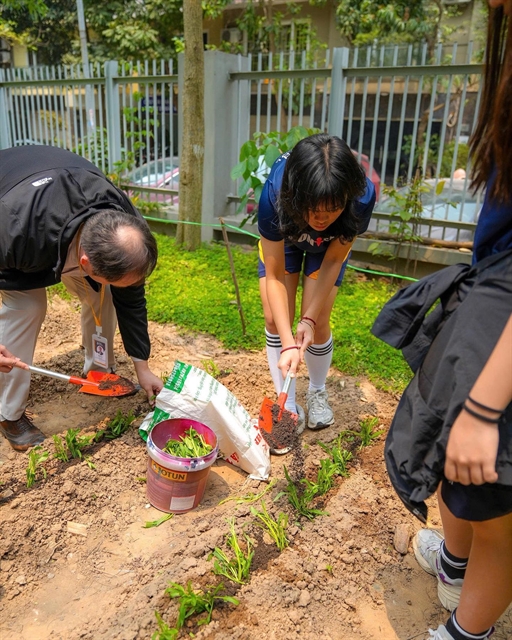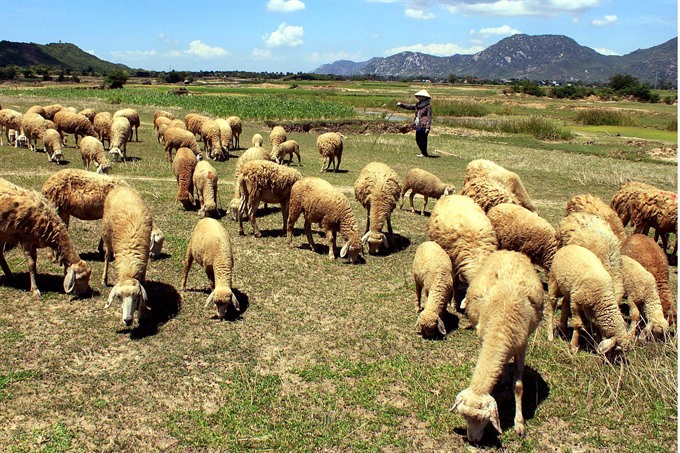 Environment
Environment

Lower water levels in reservoirs and barren farmland can be easily seen in many parts of the south-central and Central Highlands region even though it is the rainy season, reports the Nông Thôn Ngày Nay (Countryside Today) newspaper.
 |
| Sheep in the south-central province of Ninh Thuận get their feed from a dry field. Drought has caused some 900 animals in the province to become exhausted since the beginning of this year due to a lack of food. — VNA/VNS Photo Công Thử |
HÀ NỘI — Lower water levels in reservoirs and barren farmland can be easily seen in many parts of the south-central and Central Highlands region even though it is the rainy season, reports the Nông Thôn Ngày Nay (Countryside Today) newspaper.
The National Steering Committee on Natural Disaster Prevention and Control last month warned that the El Nino phenomenon is expected to appear from November to the early months of 2019, with the potential to cause severe drought.
The region’s rainfall between November 2018 and April 2019 is forecast to fall by 20-50 per cent against the average of previous years, according to the National Hydro-meteorological Forecast Centre.
It has caused lower water levels at reservoirs, rivers and springs in many localities in the regions of between 10-60 per cent in comparison with the average of many years. Khánh Hoà and Ninh Thuận provinces are likely to face a water shortage of up to 70 per cent.
Central Thừa Thiên-Huế and Ninh Thuận provinces will face drought in the first crop of 2019.
The Natural Disaster Prevention and Control and Search and Rescue Steering Board of Thừa Thiên-Huế Province reported that the province has 56 irrigation reservoirs and six hydropower reservoirs that were put into operation but most of the small- and medium-sized reservoirs have dried up.
Big reservoirs in the province also face the same situation. The water level of Tả Trạch Reservoir, for example, reached 24m last month, only one meter higher than the dead level and 2.5m lower than the water level of 2017.
The water level was blamed on the lower rainfall, which reached only 50 per cent of the average of many years, according to the steering board. It said this is considered abnormal as the rainy season lasted for months and is going to end soon.
People in Ninh Thuận Province are also struggling with the record drought when the total amount of water of all reservoirs in the locality reached only 82.2 million cu.m, while the total designed capacity is nearly 195 million cu.m.
As many as 17 reservoirs dried up or started to reach the dead level.
In Quảng Trị Province, the rainfall also fell dramatically, equivalent to 53 per cent of the average of previous years. The water level in many reservoirs reached only 26-30 per cent of the designed capacity.
A recent survey in Thừa Thiên-Huế and Quảng Trị provinces by the Directorate of Water Resources under the Ministry of Agriculture and Rural Development (MARD) shows that the provinces face high risks of drought and saltwater intrusion, seriously affecting the production activities and living conditions of local people.
An estimated total of nearly 8,500ha and 2,500ha of farmland in Quảng Trị and Thừa Thiên-Huế provinces, respectively, cannot be cultivated due to water shortage in 2019.
Head of the Thừa Thiên-Huế Department of Agriculture and Rural Development’s Plant Protection Sub-department, Cái Văn Thám, told the newspaper that local farmers would have to face a tough crop when an estimated of 2,000-2,500ha of farmland are forecast to suffer from water shortages for irrigation or they had to change production.
Head of the Directorate of Water Resources’ Department of Irrigation Work Management, Nguyễn Hồng Khanh, said that localities needed to balance water resources as well as have production plans for upcoming crops to deal with drought.
In a recent document guiding localities to prepare to cope with the 2018-19 drought and saltwater intrusion, Minister of Agriculture and Rural Development Nguyễn Xuân Cường asked localities to adjust agricultural production structure flexibly to adapt to the drought.
They were required to watch closely hydro-meteorological forecast to have proper prevention and control measures, store water at reservoirs reasonably to ensure enough water for agricultural production and daily activities of farmers while developing solutions to ensure safety for reservoirs and dams.
It was also necessary to have plans to save water, dredge canals, install pumping stations and make use of all available water sources, he noted.
The Ministry of Industry and Trade has instructed Vietnam Electricity to build plans to operate hydropower plants appropriately to ensure enough water for agricultural production, particularly those operating in the south-central and Central Highlands region. — VNS

.jpg)


